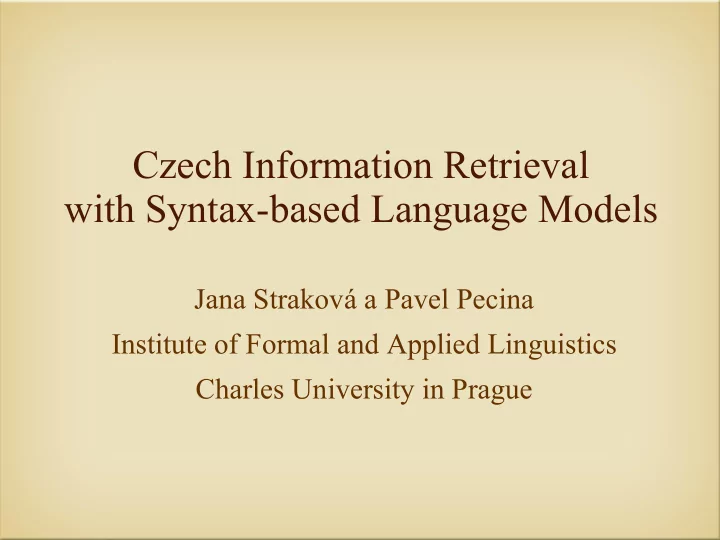

Czech Information Retrieval with Syntax-based Language Models Jana Straková a Pavel Pecina Institute of Formal and Applied Linguistics Charles University in Prague
How can we improve information retrieval? (Especially for morphologically rich languages with considerable free word order and long distance relations between words?)
Outline ● Motivation ● The Task ● Test Collection ● The Model ● Experimental Setup ● Results and discussion ● Conclusions
Outline ● Motivation ● The Task ● Test Collection ● The Model ● Experimental Setup ● Results and discussion ● Conclusions
The Task For given document collection and given query, rank documents with relevance to the query.
Test Collection ● Czech collection from Cross Language Evaluation (CLEF) Forum 2007 Ad-Hoc Track ● 81,735 documents, 50 topics ● average document length: 349.46 words ● 15.24 documents in average assessed as relevant to each topic
Test Collection ● Czech collection from Cross Language Evaluation (CLEF) Forum 2007 Ad-Hoc Track ● 81,735 documents, 50 topics ● average document length: 349.46 words ● 15.24 documents in average assessed as releavant to each topic ● Results on this shared task published in Nunzio et al., 2008: ● MAP: 35.68%, 34.84%, 32.04% ● best known MAP: 42.42% (Dolamic, Savoy (2008))
Topics ● Queries describing „information need“ in natural language. ● TREC format: a structure of three fields ● title: keyword query ● desc: more detail (one sentence) ● narr: detailed description of relevant documents ● Randomly divided into a development set of 10 topics and test set of 40 topics.
Topic Example <title> Inflace Eura </title> <desc> Najděte dokumenty o růstech cen po zavedení Eura. </desc> <narr> Relevantní jsou jakékoli dokumenty, které poskytují informace o růstu cen v jakékoli zemi, v níž byla zavedena společná evropská měna. </narr>
Vector space model for IR
Language modeling in IR ● Notation: ● document: D ● collection of documents: C ● query: Q = q 1, q 2, ... ,q n ● surface bigram: q i ,q i 1 ● dependency bigram: p q i ,q i ● Documents D are ranked by probability P(D|Q) of being (independently) generated from queries Q. ● From Bayes, we consider „reverted“ probability P(Q|D).
Language models ● Unigram model C D q i P D Q = ∏ P D q i = ∏ ● ∣ D ∣ ● Where stands for P(D|Q) and is the raw P D Q C D q i count of word in document D q i ● Bigram (surface) model C D q i ,q i 1 P D Q = ∏ P D q i ,q i 1 = ∏ ● ∣ D ∣
Dependency tree Dependency tree for sentence „The American presidential election was followed closely.“
Dependency bigram model P D Q = ∏ q i : ∃ p q i P D p q i ,q i
Experimental Setup ● baseline: plain unigram model ● comparison: surface vs. dependency bigram model
Experimental Setup ● baseline: plain unigram model ● comparison: surface vs. dependency bigram model ● lemmatization (= linguistically motivated means of stemming) ● smoothing: Jelinek-Mercer
Experimental Setup ● baseline: plain unigram model ● comparison: surface vs. dependency bigram model ● lemmatization (= linguistically motivated means of stemming) ● smoothing: Jelinek-Mercer ● combination of all models by simple linear interpolation ● coefficients fitted by simple grid search using development data ● Stopwords: 256 words from UniNE
Experimental Setup II (Tools) ● lemmatization: Hajič, 2004 ● parsing: McDonald et al., 2005 ● evaluation: MAP with trec_eval ● morphological and syntax analysis performed in TectoMT framework (Žabokrtský et al., 2008)
Results model MAP unigram-surface-form 0.3116 unigram-surface-lemma 0.3731 bigram-surface-form 0.1775 bigram-surface-lemma 0.2023 bigram-dependency-form 0.1826 bigram-dependency-lemma 0.2447 combination 0.3890
Results model MAP unigram-surface-form 0.3116 unigram-surface-lemma 0.3731 bigram-surface-form 0.1775 bigram-surface-lemma 0.2023 bigram-dependency-form 0.1826 bigram-dependency-lemma 0.2447 combination 0.3890
Results model MAP unigram-surface-form 0.3116 unigram-surface-lemma 0.3731 bigram-surface-form 0.1775 bigram-surface-lemma 0.2023 bigram-dependency-form 0.1826 bigram-dependency-lemma 0.2447 combination 0.3890
Results model MAP unigram-surface-form 0.3116 unigram-surface-lemma 0.3731 bigram-surface-form 0.1775 bigram-surface-lemma 0.2023 bigram-dependency-form 0.1826 bigram-dependency-lemma 0.2447 combination 0.3890 (all 50 topics MAP: 41.02)
Results unigram-surface-lemma 0.3731 bigram-surface-form 0.1775 bigram-surface-lemma 0.2023 bigram-dependency-form 0.1826 bigram-dependency-lemma 0.2447 combination 0.3890
Bigram surface (20.23) vs. bigram dependency (24.47)
Conclusions ● We have presented a simple dependency bigram language model for information retrieval. ● With this model, we have outperformed most of the results published in Nunzio et al., 2008. ● Finally, we have found examples, where syntax model performs significantly better than surface bigram model.
Thank you!
Recommend
More recommend